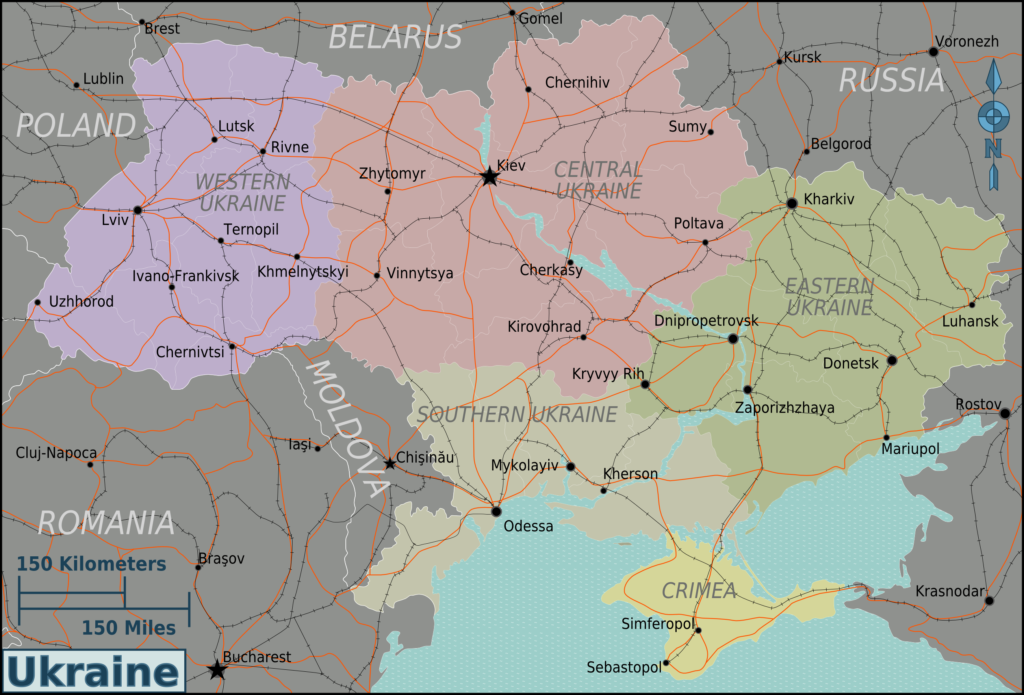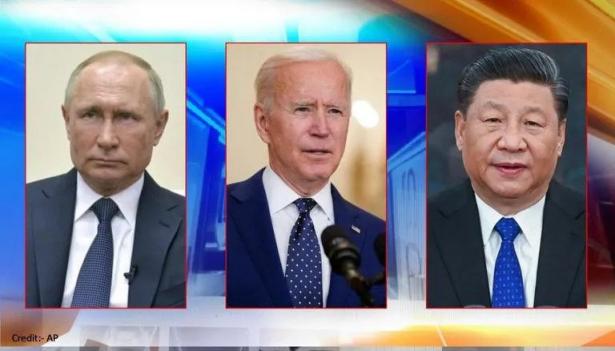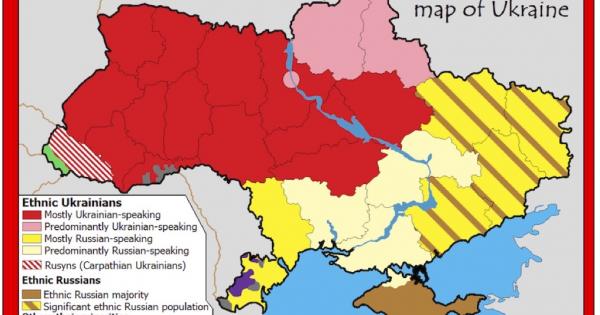The ethnic and cultural history within the formation of Ukraine, among other things, makes the resolution of the current situation immensely challenging.
By Jerry Harris and Garret Virchick
Ukraine has once again exploded into contention between Russia and the West. Where should the Left stand in this conflict? More importantly, caught between East and West, how can Ukraine resolve its internal problems based on its independence and self-determination?
To understand today’s situation, we need to start with a bit of history. In 1654 significant parts of modern-day Ukraine were incorporated into Tsarist Russia. The southern and eastern sections were added in 1920, while the far western region integrated in the 1940s, after 200 years under Austro-Hungarian rule. Crimea was added in 1954, and Ukraine as a modern nation came into existence in 1991, when 93 percent of the country approved a referendum declaring itself an independent state.
But that overwhelming vote in favor of independence contrasts starkly with the diversity of opinions about the current state of affairs in the country. There are deep divisions in Ukraine stemming from the regional divisions of history, language, identity, culture, and religion.
INDEPENDENCE AND THE RISE OF THE OLIGARCHS
After independence, the economy of Ukraine revolved around the export of raw materials, such as agricultural goods, iron ore, and coal. The eastern part of the country was industrialized and closely integrated with Russia. The western parts are more agrarian and looked increasingly towards the European market. The oligarchs that came to power through the privatization of state-owned corporations did little to develop the internal market, instead exporting billions to offshore tax havens.
As in many countries, globalization followed by the worldwide economic collapse in 2007 wreaked havoc in Ukraine. GDP fell, national debt grew, and millions left the country to find work in Russia and the EU, causing a 13% drop in the population. This economic crisis and the corruption of the ruling class brought on the recent turmoil. Although outside interference by Europe and the U.S. played a role in stoking the anger of the people, the root of the rebellion that took place in 2013 wasn’t foreign manipulation but internal conditions.
EUROINTEGRATION VS NATIONALISM
The modern globalized economy has seen a heightening of the contradiction between transnational capitalists and national capitalists. Transnational capitalists in Ukraine called for deeper integration into the European economy. These billionaires advocated ending protections for the internal markets in exchange for recognition from Europe, which would destroy various sectors of industry and increase unemployment. This strategy was opposed by national capitalists still attached to the internal economy and lacking sufficient capital to join the transnational elite.
This contradiction laid the groundwork for political upheaval in 2013, as President Victor Yanukovych sought loans to meet Ukraine’s skyrocketing debt obligations. The $17.5 billion offered by the International Monetary Fund (IMF) came with neoliberal “reforms” that the transnational capitalists favored. The $15 billion Russian package contained no such reform demands and was backed by Ukraine’s national bourgeoisie.
Yanukovych vacillated between the two packages. His political base was in the country’s pro-Russian east. In the end he opted for the Russian package, which outraged Ukrainians in the country’s west who wanted stronger ties with Europe. This set off massive demonstrations that came to be called Euromaidan, after Maidan Nezalezhnosti, the central square in Kyiv where the protests took place. The civil unrest combined with government repression became increasingly violent on both sides with 130 confirmed deaths. By February Yanukovych was forced to resign and fled to Russia.
DEMOCRACY OR NEOFASCISM?
While the mass of Maidan protesters were largely liberal pro-Western activists, the absence of progressive leadership left a vacuum that was filled by anti-Russian right-wing nationalists, many of whom celebrated the pro-Nazi activities of Ukrainian fascists in World War II. With an ideological, cohesive, and motivated membership, they were able to play a leadership role.
Yanukovych was replaced as president by one of the lesser Ukrainian oligarchs, Petro Poroshenko. Many people in the eastern region felt that this violated the national elections. Some had never fully accepted the 1991 split with Russia. A movement arose that began to call for autonomy or independence. In response, the new government in Kyiv launched armed attacks which they called an anti-terrorist offensive, even though the eastern protests were no different than the beginnings of the protests in the west. Ethnic and regional differences were inflamed. Supporters of the new government labeled Eastern Ukrainians as vulgar, ignorant, and less educated. In the east, the new government was painted as a fascist junta, a threat to Russian language and cultural rights.
This conflict led to civil war. The government formed by Poroshenko was in the hands of neoliberal pro-Western elites. But proto-fascist forces were an important part of the governing alliance. The Svoboda party, which claims the tradition of the pro-Nazi Ukrainian Insurgent Army that participated in the mass killing of 70,000 Jewish and Polish citizens in World War II, received six cabinet positions. In addition, to help put down the revolt in the east, right-wing militias like the Azov battalion were recruited. The Azov battalion carries the Wolfsangel flag, formerly used by Hitler’s SS.
Poroshenko was ultimately defeated by Volodymyr Zelensky in the 2019 presidential elections. Zelensky, a reality TV star, rode to victory on an anti-corruption campaign. But his popularity has been waning and his regime is becoming more autocratic. He recently banned an opposition news site and sanctioned its editor.

Ukraine regions. Map by Peter Fitzgerald, CC BY-SA 4.0, via Wikimedia Commons
RUSSIA, CRIMEA, AND THE ROOTS OF THE CURRENT CONFLICT
Under attack and labeled as “terrorists,” the people in eastern Ukraine organized armed self-defense militias to combat the western military offensive. But the battle did not stay internal. Russian arms and volunteers quickly crossed the border to join the fight. Many of these volunteers were reactionary pan-Slavic nationalists. Alexander Borodai, who became prime minister of the self-proclaimed Donetsk People’s Republic in the Donbas region of Ukraine, came from a group that published the far-right newspaper Zavtra. His rebel commander, Igor Strelkov, is known as a Christian religious zealot.
In a violation of national sovereignty, Russia invaded Crimea in early 2014 and eventually annexed the region. Vladimir Putin maintained that if the people of Crimea or Novorossiya (a proposed confederation of the self-proclaimed Donetsk People’s Republic and Luhansk People’s Republic in Donbas) want to secede, they have the legitimate democratic right to do so. Left scholar and activist Alexander Buzgalin pointed out Putin’s hypocrisy, given his denial of democratic rights to nationalities within Russia that also want self-determination.
Russia’s invasion and annexation of Crimea led to economic sanctions by the West. As Russian Marxist Boris Kargarlitsky points out, “The situation confronting our elites in this respect is more or less straightforward; they cannot enter actively into confrontation with the West without dealing crushing blows to their own interests, to their own capital holdings and to their own networks, methods of rule and way of life.” According to Credit Suisse, Russia’s 110 billionaires control 35 percent of the nation’s wealth. There is no doubt that the economic boycott has hurt.
In the West, Gideon Rachman, the political editor for the Financial Times made similar observations: “The deep connections between politics and business in modern Russia mean that the country’s most powerful people often have a direct personal stake in the continued prosperity of Western Europe. They have business relationships to maintain, investments to protect, houses in the south of France, children at school in Britain…people with international business interests tend not be nationalists. They cannot afford to be.” But this also held true for Western transnational capitalists; the ties are a two-way street crossing borders and nationalist politics. Hurting Russian economic interests hurt Western interests as well.
While the sanctions have hurt, in the long term Russia’s strategy seems to focus on keeping Ukraine out of NATO, protecting Russian language and cultural rights, and maintaining strong ties with the Ukrainian economy.
NATO AND THE RUSSIAN BUILDUP ON THE BORDER
The Ukrainian people are bearing the brunt of the conflict between competing capitalist interests. Transnational capitalists want a country integrated into Europe, and they unite with proto-fascists to ensure that direction. Capitalists rooted in the internal economy support right-wing nationalists and religious zealots to maintain their power. Russia amasses troops on the border demanding that Ukraine not join NATO. Western elites say it’s up to Ukrainians to decide, while holding meetings with Russia without Ukrainian representatives. But what do the Ukrainian people really want?
In a recent article published in LeftEast, Volodymyr Ishchenko points out that Ukrainians are far from unified about NATO. He calls the Euromaidan movement a deficient revolution that did not form any national unity, but simply benefited a section of elite oligarchs. Ukraine’s neutral status is ingrained in its constitution, which expressly forbids it from entering any military bloc. In fact, NATO membership was supported by only a small minority prior to the events of 2014. Although support for NATO membership jumped up to 40 percent after Russia’s annexation of Crimea, it may still be a minority opinion in the population.
Ishchenko further points out the reasons for the increase in support. One is that Russia’s invasion convinced previously skeptical Ukrainians to seek protection against further Russian hostilities. But also, and perhaps more importantly, the survey no longer included the most pro-Russian Ukrainian citizens in the east of the country!
IS THERE A PATH FORWARD?
In December of 1917 the First All-Ukrainian Congress of Councils declared the formation of the Ukrainian Soviet Republic. The Congress formed a close alliance with the Russian Soviet Federative Socialist Republic and after a long civil war, in 1922 became a founding member of the Union of Soviet Socialist Republics. These first worker-led revolutions inspired millions of people around the world. But while there were tremendous advances made by the working classes, there were also serious mistakes made in these first attempts at building socialist society. Socialism in Ukraine ended in failure with the breakup of the USSR in 1991. To build a truly democratic socialism today it will take a critical examination of both the internal and external factors that led to this collapse.
In the past 31 years post-Soviet Ukraine has done little to solve the problems that arose during those 75 years of Soviet-style socialism. And it is equally true that geopolitical maneuvers by the United States and EU in the West or Putin’s Russia in the East will not provide the answers. Ukraine’s problems must be solved by the diverse sectors of Ukrainian society.
To that end, the U.S. Left must oppose any attempt by the Biden administration to include Ukraine in NATO. The expansion of NATO is doing little to provide peace and stability. Rather its move into Eastern Europe is seen as a provocation, heightening the tensions in the region. CODEPINK, the women-led grassroots organization working to end U.S. wars and militarization, has put out a petition demanding NATO and the US stop escalating the conflict in Ukraine.
Ishchenko suggests that the Minsk Accords, which brought about a ceasefire after the Russian invasion of Crimea and massive fighting, might offer a path forward by involving the pro-Russian, breakaway eastern portions of Ukraine with the rest of the country in decision-making about the country’s future. But there is no international body with the legitimacy and the will to elbow Russia and NATO out of the way and bring all factions of Ukrainians to the table.
As this article goes to press tensions are high in the region, with Russian troops amassing on the border of Ukraine. While nothing is certain, a Russian invasion is a strong possibility. When and if that happens, civil war within Ukraine is likely. There is already maneuvering in Kyiv. Poroshenko recently returned to Kyiv to face charges leveled by Zelensky, who accuses him of treason and support for terrorism during his tenure as president, when he allowed the purchase of coal from mines controlled by Russian-backed separatists in the east. Poroshenko, who has a base in Ukrainian nationalist politics, is criticizing Zelensky for giving ground to Russia in peace negotiations.
Short of the emergence of a progressive people’s movement in Ukraine, there may be little that can be done to stabilize the country and prevent bloodshed. But what is also needed, given the role of Putin’s Russia, is a strategy the Bolsheviks called “revolutionary defeatism.” Lenin called on revolutionaries to wage a campaign advocating the defeat of their own government during World War I as the Tsar sent countless Russian soldiers to die in that imperialist war. Progressives in Russia should consider this if Putin decides to invade Ukraine. Learning the lessons of the past is the order of day for all of us working to build a better, more socialist future.









